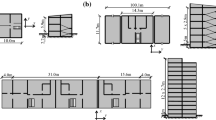Summary
1. In the first approximation buildings exposed to the effects of explosions may be regarded as elastic systems with one degree of freedom.
2. As the seismic action increases, the maxima of the frequency responses (ratios of the vibration spectra of the tops of the buildings to the vibration spectra of the soils) fall somewhat.
3. The frequencies of the soil spectrum maxima do not coincide with the natural frequencies of the building vibrations; accordingly, the ratios of the maximum amplitudes of the building vibrations to the maximum amplitudes of the soil vibrations do not attain the value of the maxima of the frequency response characteristics of the building vibrations. These ratios depend on the inclination of the branches of the soil spectra and do not increase with increase in the seismic load.
4. When exposed to the action of explosions, the foundations of buildings vibrate, like the underlying soils themselves, or possess a small indicated amplification, which does not lead to an increase in the amplitudes of the foundation vibrations.
Similar content being viewed by others
Literature cited
V. S. Medvedev, "Investigation of the vibrations of buildings under seismic loads," Trudy IFZ, No. 5, 172 (1959).
S. V. Medvedev, "Effect of internal friction forces on the vibration of buildings during earthquakes," Trudy Geofiz. In-ta, No. 36, 163 (1956).
A. A. Kharkevich, Spectra and Analysis [in Russian], Fizmatgiz, Moscow (1962).
N. P. Grudeva, L. N. Malinovskaya, and B. N. Naimark, "Approximate calculation of seismic vibration spectra," in: Computational Seismology, Vol. 3 [in Russian], Nauka, Moscow (1967).
Building in Seismic Regions. Design Standards. Construction Specifications and Regulations II-A.12-69 [in Russian], Stroiizdat, Moscow (1970).
S. V. Polyakov, F. V. Bobrov, et al., Design of Earthquake-Resistant Buildings [in Russian], Stroiizdat, Moscow (1971).
S. V. Puchkov, "Velocity and acceleration spectra of strong earthquakes referred to various soils," in: Engineering Seismology, Nos. 3, 4 [in Russian], Donish, Dushanbe (1966).
Additional information
Institute of the Earth's Crust, Siberian Division, Academy of Sciences of the USSR, Irkutsk. Translated from Osnovaniya, Fundamenty i Mekhanika Gruntov, No. 3, pp. 18–20, May–June, 1974.
Rights and permissions
About this article
Cite this article
Potapov, V.A. Investigation of the explosion-induced vibration of buildings. Soil Mech Found Eng 11, 170–173 (1974). https://doi.org/10.1007/BF01706266
Issue Date:
DOI: https://doi.org/10.1007/BF01706266




